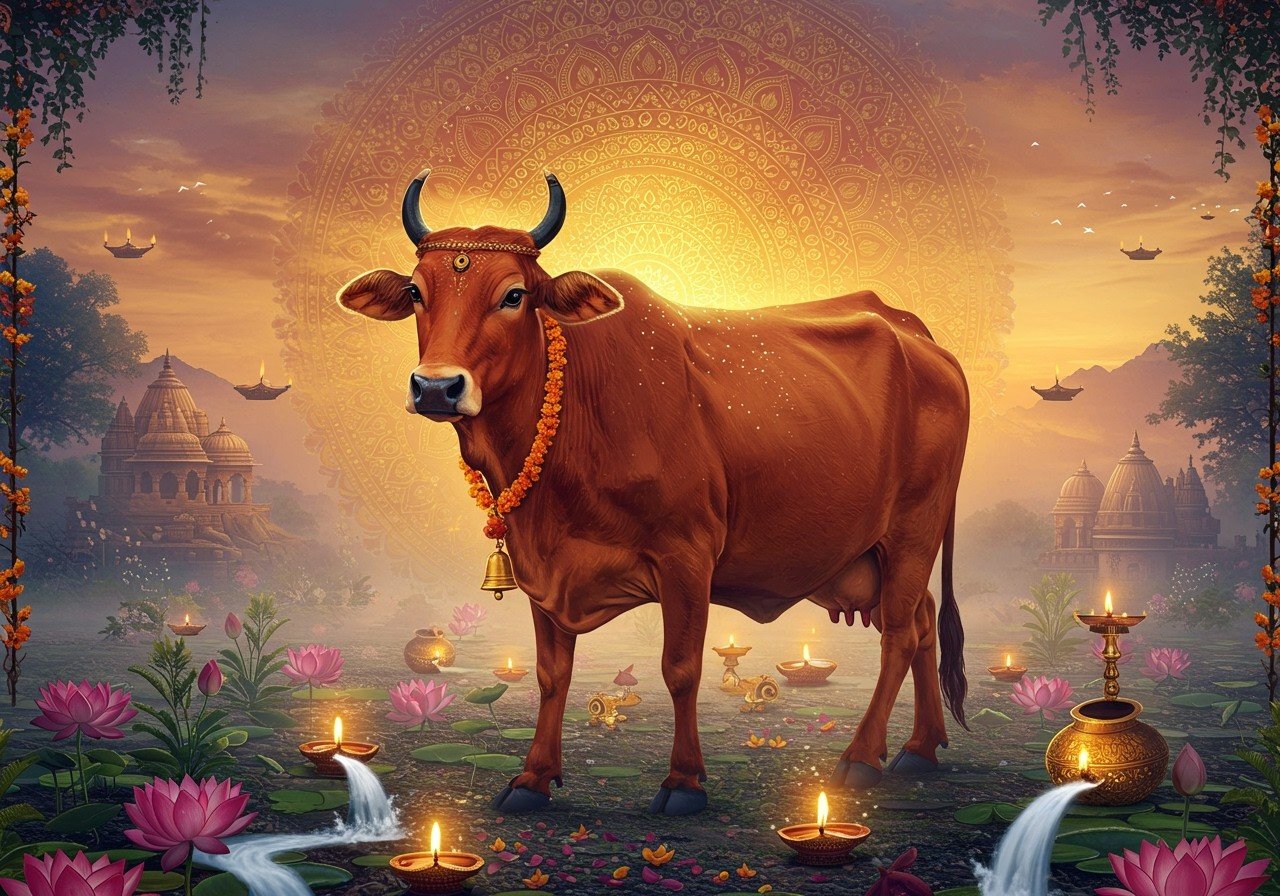The Sacred Kapila Cow in Hinduism: Symbol of Divinity and Abundance

The Kapila Cow holds a special place in Hinduism, symbolizing divinity and abundance. Revered for its sacred qualities, this unique cow is deeply rooted in Hindu mythology and culture. Let’s explore its historical background, spiritual significance, and its role in modern practices. You can find beautiful Kapila Cow idols and other puja items at poojn.in, India’s largest store for cultural goods and services.
Historical Context and Origins
The Kapila Cow’s origins can be traced back to ancient Hindu scriptures, including the Vedic texts, where it is associated with deities and sages. Historically, cow worship has evolved in Hindu society, establishing the Kapila Cow as a symbol of prosperity and abundance, particularly in agricultural communities where it plays a vital role in sustaining livelihoods. Across India, regional variations in the worship and symbolism of the Kapila Cow reflect the diversity of cultural practices.
Symbolism and Spiritual Significance
The Kapila Cow embodies purity and fertility in Hinduism. It is deeply connected to the divine cow Kamadhenu, known as the “cow of plenty,” representing blessings, abundance, and prosperity. The Kapila Cow embodies these qualities, holding profound spiritual significance in religious rituals. It’s a form of Devi, the Hindu Divine Mother.
In ceremonies, devotees invoke the Kapila Cow for blessings and prosperity, believing its presence brings purity and divine energy. The color of the Kapila Cow often carries philosophical interpretations, sometimes representing cosmic balance and harmony in the universe. Reverence for the Kapila Cow teaches ethical and moral lessons, encouraging kindness, compassion, and respect for all living beings.
Mythological Stories and Legends
The tales of the Kapila Cow are rich with moral and spiritual lessons. A popular story involves the sage Kapila, often linked with the Kapila Cow, highlighting themes of wisdom and spiritual insight. This sage is believed to have emerged during the Samudra Manthan, or churning of the cosmic ocean. Another captivating tale from the Puranas describes the churning of the ocean (Samudra Manthan), where Kamadhenu emerged as a divine gift, closely linked to the concept of the Kapila Cow.
These stories influence Hindu art, literature, and performance traditions, inspiring creative expressions that celebrate the sacredness of the Kapila Cow. Through these narratives, the cultural significance of the Kapila Cow continues to thrive.
Contemporary Relevance and Practices
Today, the Kapila Cow maintains its special place in Hindu rituals and festivals such as Gopashtami, where cows are honored for their role in life and spirituality. The Kapila Cow also promotes sustainable agricultural practices in rural communities, supporting ecological conservation efforts. The gau seva (cow protection) movement emphasizes the importance of preserving cow welfare, sparking social and political discussions about animal rights and environmental stewardship.
Despite globalization and urbanization, traditional respect for the Kapila Cow endures. While shifts in cultural priorities may influence practices, the core values associated with the Kapila Cow remain strong. Find authentic puja items for cow worship at poojn.in.
Visual Representation and Artistic Depictions
The Kapila Cow has been depicted in Hindu art and iconography for centuries. Paintings, sculptures, and temple carvings showcase its beauty and spiritual essence, often incorporating symbolic motifs that convey deeper meanings. Notable artists have contributed to this visual portrayal, enhancing spiritual understanding. In contemporary media, imagery of the Kapila Cow continues to inspire modern aesthetics and design, reflecting a blend of tradition and innovation that enriches cultural narratives. These visual representations reinforce devotion and connection to Hindu values. For authentic brass Kamdhenu Cow idols, visit poojn.in.
Kamadhenu: The Divine Cow of Plenty
Kamadhenu, also known as Surabhi, is a divine bovine-goddess in Hinduism, revered as the mother of all cows and a symbol of abundance and prosperity. Worshippers believe she can fulfill desires and bestow blessings. She is often depicted as a white cow, sometimes with a female head and breasts, or containing various deities within her body.
- Origin: Kamadhenu emerged during the Samudra Manthan (churning of the cosmic ocean). Some scriptures say she arose from the milk ocean; others state she was born from Daksha or Prajapati. Find puja essentials for cow worship at poojn.in.
- Names: Besides Kamadhenu and Surabhi (“fragrant” or “pleasing”), she’s also known as Sabala (“the spotted one”) and Kapila (“the red one”).
- Kapila Cows: Kamadhenu is the mother of all cows, including Kapila cows. Some accounts say Surabhi gave birth to many golden Kapila cows, considered mothers of the world. Browse our collection of holy idols at poojn.in.
- Symbolism: Kamadhenu represents blessings, abundance, prosperity, motherhood, love, purity, and maternal care. Her four legs symbolize the four Vedas, her horns the three main gods (Brahma, Vishnu, and Shiva).
- Role in Hinduism: Kamadhenu plays a key role as a symbol of motherhood and abundance, a form of Devi (the Hindu Divine Mother), and closely related to Mother Earth (Prithvi). All cows are venerated as earthly embodiments of Kamadhenu. We offer traditional brass items for go-puja rituals at poojn.in.
- Wish-Fulfilling: Kamadhenu is known for granting wishes and bestowing blessings, abundance, and prosperity. Shop our wide range of products at poojn.in.
- Association with Brahmins: Kamadhenu is associated with Brahmins, symbolizing their wealth. Her milk and milk products are essential for Vedic fire sacrifices.
How Poojn.in Supports the Sacred Kapila Cow Tradition
Poojn.in offers authentic brass Kamdhenu cow idols and related puja items, helping devotees connect with this sacred tradition. Our collection includes:
- Pure Brass Kamdhenu Cow with Calf idols (5.5″ x 4″) – Ideal for home temples and worship. Browse our collection.
- Traditional brass items for go-puja rituals. Explore our holy utensils.
- Puja essentials for cow worship ceremonies. Shop now.
- Quality-checked, authentic materials that meet religious requirements.
Visit Poojn.in or download our app to explore our complete range. We deliver across India and offer expert guidance on product selection and ritual significance.
Conclusion: Embracing Tradition and Reverence
The Kapila Cow’s timeless presence in Hindu culture symbolizes purity, fertility, and divine blessings. Its stories and significance are woven into Hindu mythology, art, and daily life. From ancient legends to modern practices, the Kapila Cow inspires kindness, compassion, and respect for all beings. In our changing world, it reminds us of the values that bind communities and traditions. Through rituals, art, and ecological practices, we continue to honor the Kapila Cow, celebrating its role in sustaining spiritual and earthly harmony. Embracing this sacred symbol connects us with deep cultural roots, ensuring its timeless lessons guide future generations.


